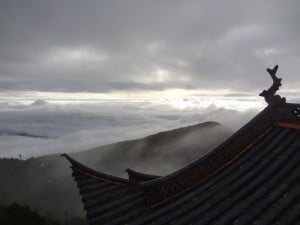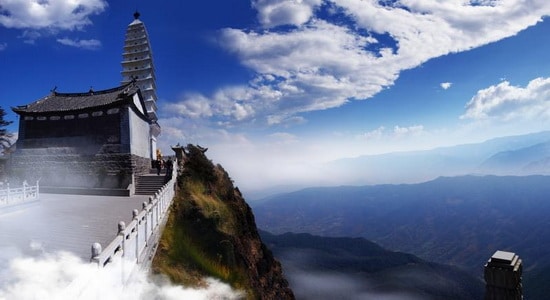I’m not a meteorologist, but in my travels I’ve noted that China is a fairly foggy country, whether from mist or pollution or some combined miasma. Traditional Chinese paintings frequently depict dark green mountaintops rising out of swirling clouds. But it’s pretty clear that these artists painted a selective view of the scenery. Many of the famous peaks in China – Taishan, the Yellow Mountains, Emeishan – are frequently shrouded by clouds. The majestic views promised by guidebooks more often than not turn out to be obscured by gray. Hiking on a clear day guarantees good views. Hiking into the fog is risky, but nothing is more spectacular than making it above the sea of clouds.
Though I have friends who are cloudchasers, so to speak, when I’ve hiked in China I never considered the weather or expected a sea of clouds. This is just as well, or else I would have been disappointed by a recent hike to Emeishan in which I was submerged in the sea of clouds the entire time, covered in a fine mist for two days in which the fog never relented, not even at the wind-blown, sub-zero summit. When I hiked Jizushan in Yunnan, however, the sea of clouds saved the day.
 Yunnan’s notoriously exotic microbiota had given me a serious stomach ache by the time we reached Jizushan. With the summit well above 3000 meters, I could feel the altitude every step of the way. My feet felt like lead, and my head pounded from the lack of oxygen. By the time we reached the top, it was already dark. We stayed overnight in a monastery on the summit. A friendly guide at the local restaurant recommended I eat raw garlic to make my stomach feel better. I didn’t want to seem rude, so I obligingly ate several cloves.
Yunnan’s notoriously exotic microbiota had given me a serious stomach ache by the time we reached Jizushan. With the summit well above 3000 meters, I could feel the altitude every step of the way. My feet felt like lead, and my head pounded from the lack of oxygen. By the time we reached the top, it was already dark. We stayed overnight in a monastery on the summit. A friendly guide at the local restaurant recommended I eat raw garlic to make my stomach feel better. I didn’t want to seem rude, so I obligingly ate several cloves.
I spent the entire night tossing and turning, feeling the garlic burning in my stomach and struggling to breathe in the thin air. In the morning we bundled up in the few clothes we had and stepped out to explore the temple on the top of the mountain. The summit was very quiet, sounds seemingly dampened by the thick fog. Over one precipice, I saw the outlines of mountains in the distance begin to emerge. Slowly, the clouds began to dissipate, revealing our perch on the top of the mountain above one sea of clouds and beneath another. This layer stayed open for less than ten minutes, during which we ran around to each wall of the monastery to look out over the mountain. The view was truly spectacular, and well worth any discomfort along the way. Before long, the fog closed in again, reminding us that chasing views in clouds is a matter of blind luck.
我不是一个气象学家, 但是在我的旅行中我发现中国是一个相当多雾的国家,
虽然我有一些喜欢追云的朋友,但话说回来,当我徒步在中国,
当我们到达鸡足山时,
我全靠脚步的引导,我的大脑已经因为缺氧而崩溃了。
我整个晚上都在辗转反侧,感觉大蒜正在我肚子里燃烧,


